Against the Grain: The Emergence of Queer Woodworkers
by John-Duane Kingsley
Members of the LGBTQIA+[1] community have long participated in the historical evolution of domestic handicraft and trade, but their contributions have largely been overlooked by scholarship and collecting institutions until the past decade.
The rise of LGBTQIA+ craft representation began with Queer Threads: Crafting Identity & Community, curated by John Chaich at the Leslie-Lohman Museum of Gay and Lesbian Art in 2014. The landmark show was the first to explore how textile production served as source of personal identity formation, cultural critique, and resistance to heteronormative ideals of capitalism, gender roles and identity, labor, and domesticity. Since Queer Threads debuted, other medium-specific exhibits followed: Sexual Politics: Gender, Sexuality & Queerness at the Northern Clay Center (2015), Transparency: An LGBTQ Glass Art Exhibit at the Museum of Glass (2019–2021), and Queering Masculinity: NYC Jewelry Week (2020). However, within this groundswell of representation, LGBTQIA+ woodworkers have yet to receive the same level of exposure or attention within craft focused institutions.
Conscious of this dearth in visibility, the Center for Art in Wood in Philadelphia, PA, initiated a series of roundtable discussions focused on providing a space for LGBTQIA+ woodworkers to connect, share how their identity reflects in their work, and collectively advocate for greater representation within the field. As a queer design historian, it was my privilege to host the first two roundtables that occurred virtually in the summer of 2021. Participating artists included those featured in the interview below: Phoebe Kuo, Adam Atkinson, Steven KP, and Gina Siepel. Although the interview doesn’t reflect the depth of our discussions, it provides an illustrative glimpse into the lived experiences and creative processes of queer woodworkers who actively seek to challenge the established heteronormative societal and creative traditions that characterize their field.
Phoebe Kuo
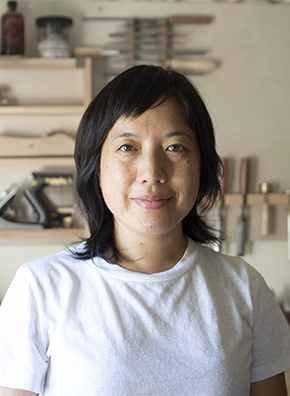
Phoebe Kuo. Image courtesy of the artist.
What are your pronouns and how do you identify?
(she/her) I’m a queer female woodworker of color, second-generation Taiwanese-American, daughter of mathematicians, designer, woodworker, artist, married, and an incorrigible night owl.
What is your relationship to queerness?
I claim queerness as a resistance to systems that weren’t made with me in mind!
How does queerness influence your work in terms of themes, processes, and relationship to labor, and can you cite specific examples in your work?
To me, craft feels inherently queer, in that it proposes an alternative path to established systems, for instance capitalism, market value, Art with a capital A. It’s not an efficient way to do things, certainly not the mainstream way of doing things. Yet it is the way I do things. A sense of craftsmanship is something I learned from my parents. They are not especially inclined toward making things, but as mathematicians they emphasized mastery through practice. I learned about the joy of mastery from them. It is exhilarating. In terms of process, my practice takes traditional techniques and places them in non-traditional contexts. I adapt coopering, which is traditionally used in barrel making, to make site specific sculptures that refuse the normal placement of both furniture and art. My work often occupies spaces that are overlooked, like corners, borders, and edges. I place it in what appears to be a precarious position—but it does just fine. It’s not exactly a self-portrait, but my work captures my orientation in the world. I see the refusal of categories, of working across art, design, and craft, as queer. It’s impossible for me to separate my queerness from my other identities, especially being Asian American and female.
What struggles/joys have you found in the woodworking field as a result of your identity?
Lack of representation can be disappointing—I often find myself in spaces where no one looks like me, and it requires a little imagination to see a path forward in these spaces. But on the whole, my identity is a source of joy and connection.
Are there any queer theorists, artists, mentors, etc. who’ve specifically influenced your work?
I draw strength from other queer artists for sure, but also Asian American artists. The poet and novelist Ocean Vuong sets an example of queer excellence and a powerful reading of queerness. He says (and I paraphrase) that while queerness is sometimes framed as a deprivation, it’s actually generative because it demands alternative innovation. When you’re in a space that wasn’t made for you, you figure out.
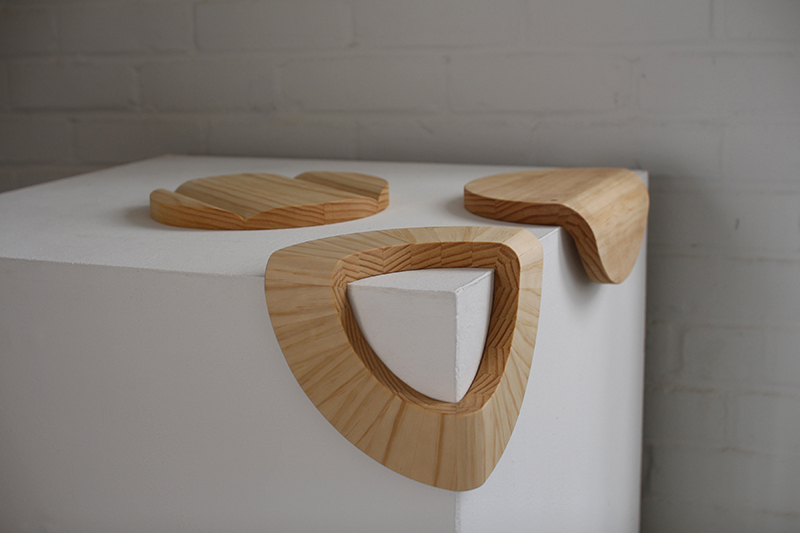
Phoebe Kuo, Jewelry for Furniture, 2018. Vertical grain douglas fir. Image courtesy of the artist.
Adam Atkinson
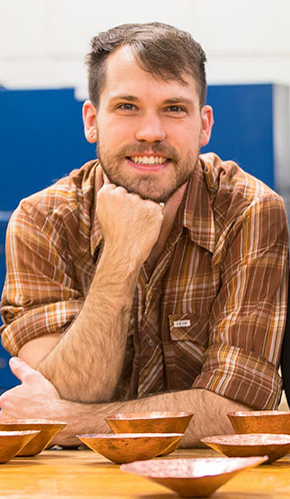
Adam Atkinson. Image courtesy of the artist.
What are your pronouns and how do you identify?
(he/him; they/them) I am a first-generation college graduate, a child of working-class parents, and a jewelry artist working with wood. I’m invested in the transformative power of art and engage in this passion as an educator and curator.
What is your relationship to queerness?
I am a cis-gendered[2] gay man who approaches making through a queer lens. I am interested in developing visual form and material language around issues of queer identity through woodcarving and body adornment.
How does queerness influence your work in terms of themes, processes, and relationship to labor, and can you cite specific examples in your work?
I enjoy using wood and metal because both materials resist what the maker wants them to do much in the same way that the jewelry and wood fields have resisted LGBTQIA+ participation. My goal in working with these materials tends to be finding a way to make them seem antithetical to their underlying properties. Aesthetically I’m drawn to soft organic forms which contrasts to their rigid, hard properties. In that way, I am disguising the material much in the same way I must disguise myself in public, hetero spaces. Formally, my work depicts the abstracted body which doubles down on my interest in obscuring the nature of both material and subject matter for the purpose of making the body a sight of ambiguity. I’m interested in the cultural/social construction of nature. By default, studies in natural history have leaned toward a heteronormative, colonial discourse which ignores the queer/BIPOC other and fabricates narratives that legitimize hetero ways of being. My goal is to undermine these narratives through subtle forms and visual language. I draw upon personal, lived experiences as inspiration for my work, and use animals, plants, and natural history display mechanisms as a familiar lexicon to accomplish this.
What struggles/joys have you found in the woodworking field as a result of your identity?
Woodworking is a field which has strong influences coming from heteronormative masculine culture. As a first-generation college student, I approached the woodshop feeling out of place. I am a queer individual who did not have the guidance or know-how to understand that the field extended beyond DIY woodworking magazines/TV shows that typically portray straight men. Because of that I discovered my interest in woodcarving later in academia, and am mostly self-taught. I find a lot of joy though in working with wood. I think of wood as a borrowed body in a lot of ways, an organism which had a previous life and reveals its years through layers of removed material. I am fascinated by the relationship that develops between myself and the carved block as I undertake each project. I also find joy in meeting others who have overcome similar barriers, and finding ways to band together to make our voices stronger.
Are there any queer theorists, artists, mentors, etc. who’ve specifically influenced your work?
I am not as well-read as I wish to be, but I do have a vested interest in Donna Haraway, Judith Butler, and Jack Halberstam. Each of these theorists have been influential in the development of my ideas, and I return to them often.

Adam Atkinson, Touching Trophy, 2019. Basswood and steel. Image courtesy of the artist.
Steven KP
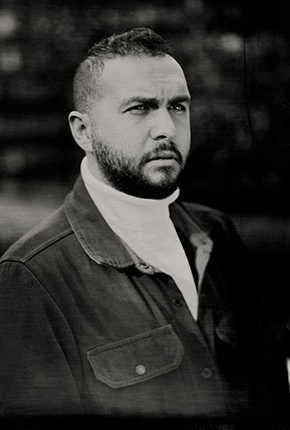
Steven KP. Image courtesy of the artist.
What are your pronouns and how do you identify?
(he/they) I am an artist, jeweler, and educator based in Providence, RI, and currently a Visiting Assistant Professor at the Massachusetts College of Art and Design. I received my MFA in Jewelry and Metalsmithing from the Rhode Island School of Design and hold a BFA from the University of Wisconsin-Madison. My studio practice is centered around investigations of empathy, material culture, and queer experience.
What is your relationship to queerness?
I think relationship may be a bit of a wrong wording—my existence as a queer body and human is pretty all encompassing as I work as an artist, educator, and community member. Whenever I struggle to find the words I go to the following quote from bell hooks: “Queer is not about who you’re having sex with—that can be a dimension of it—but queer as being about the self that is at odds with everything around it and has to invent, and create, and find a place to speak, and to thrive, and to live.”
How does queerness influence your work in terms of themes, processes, and relationship to labor, and can you cite specific examples in your work?
I begin by thinking about bodies—my body, the wearers and carriers of my work, or the work itself. When cast as the other, a body comes under stress. Space ceases to conform to its presence and movements. The societal structures that are meant to guide, support, and confine the conventional body all fail and fall short. To pass, in a queer dialogue, is to be able to be seen as the conventional or the expected. Passing is an allowance to exist without constant fear of retaliation for being your authentic self in a system where authenticity is antagonistic, undesirable, other, queer. My knot works became an opportunity to explore the un-ending, ongoing nature of living with trauma in a way that allowed me to embrace the tenderness and slowness that working with it required. When I approach the blank of wood, the knots and their forms are already within. As I spend time with the wood, carving, removing material, refining the surfaces and refining the wounds, the knots lighten, the knots loosen. I call them “Partially Undone,” and that’s all they can ever be. My “Partially Undone Knots” pass as knots—as not-wood. Until they are handled, the weight, or lack thereof, defies what is conventionally expected.
What struggles/joys have you found in the woodworking field as a result of your identity?
I have experienced overt homophobia and transphobia in this field. Just this past week there were several public forums that hosted transphobic dialogue—during pride. The craft world is steeped in tradition and rigidity. “Proper” forms of making, “correct” technique can often very rapidly extend to what bodies and identities are allowed to make “true craft.” This is compounded by a heritage of predominantly cis-white and often straight male voices that have held positions of power and been stewards (and gate-keepers) of knowledge in our craft. There is—against all of these forces—a thriving and growing dialogue of queer voices and inclusive dialogues that are taking place and in those spaces our work and our conversations can be healing, empowering, and radical.
Are there any queer theorists, artists, mentors, etc. who’ve specifically influenced your work?
Paul B Preciado’s “my body does not exist” was a seminal text in my journey into body politics and queer theory. I have ongoing critical discussions with matt lambert who is a mentor and dear friend in this field.
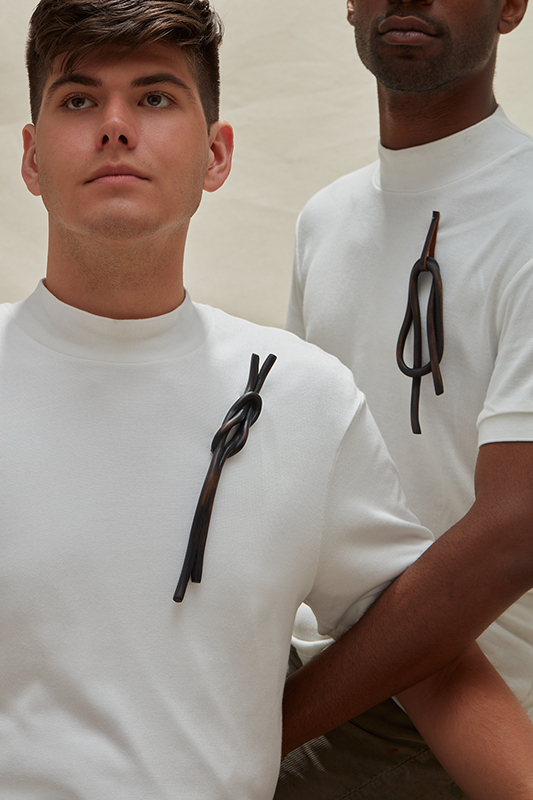
Steven KP, “Partially Undone Knots” brooches carved in cherry, sterling silver, and steel, 2021. Image courtesy of the artist.
Gina Siepel
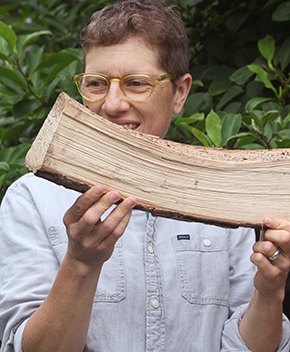
Gina Siepel. Image courtesy of the artist.
What are your pronouns and how do you identify?
(she/they) Life experience has taught me that gender is primarily socially constructed. I was raised as a “girl” and she/her pronouns were ascribed to me. Being socialized this way in the late 20th century in a rural, primarily white community, I never questioned this use of language, although I did not feel like a girl and I presented/identified in primarily masculine or gender-nonconforming ways. I embrace my complex gender experience and accept the fluidity of this situation. I also identify as an artist who works conceptually with elements of American furniture history, an artist engaged with environmental concerns, a woodworker, and an educator.
What is your relationship to queerness?
I have been queer since before I was “Queer.” And as I became “Queer,” I became queerer, and much happier and more free! (Though still subject to the rigors of life under capitalism.)
How does queerness influence your work in terms of themes, processes, and relationship to labor, and can you cite specific examples in your work?
At this point in my artistic practice, identity is most interesting to me as a way of looking outward at the world. Although my identity is sometimes a primary subject in my work, I like to think I’m using a deeply queer lens to make work in response to the complexity of the world I live in. So my projects tend to be based on questions, curiosity, and a desire to learn and engage with others, human and non-human. I think that actually the whole world is so queer, by which I mean complex, interconnected, non-categorical, non-individuated, fluid, ever-changing, paradoxical, and rife with tangential forms of creativity, remixes, appropriations, and productive failures of all kinds. I think my job as a queer artist is to welcome and engage the proverbial multitude, to explore and speculatively model ways of living with complexity, and to wrestle with the contradictions and paradoxes of life in the world.
What struggles/joys have you found in the woodworking field as a result of your identity?
For better or worse, I didn’t go through most of the normal channels of fine woodworking education. I grew up on a farm in a rural part of western New York. My dad liked rustic farm woodworking, and we were always building things. In 1996, I landed in Brooklyn, NY, with a freshly minted BFA in painting and drawing. Waitressing made me miserable, so I found my way to woodshops. My first job was as a sander and finisher in a shop that built high-end frames, but the owner wouldn’t teach me to use any of the machines, seemingly because of my gender. After nine months of full-time sanding, I found my way to the theater world and began working in big commercial shops as a low-skilled laborer. I worked very hard to learn the trade, but my challenges were compounded by sexism and homophobia. I did find a few wonderful skilled mentors who were generous with their knowledge, and that and my own curiosity about the process formed the basis of my learning. Becoming a skilled trade carpenter in this industry was challenging and physically exhausting, but it was extremely empowering in relation to my queer and feminist identities. Over the years I have also taught woodworking, carpentry, and sculpture to a lot of people, including many queer students. I love seeing them experience the empowerment that comes along with the skillset.
Are there any queer theorists, artists, mentors, etc. who’ve specifically influenced your work?
I’m influenced by feminist and queer-feminist theoretical discourse, but influences are numerous and distributed. Here are a few: theorist Jack Halberstam’s Queer Art of Failure is a major influence, as well as Jose Munoz’s Cruising Utopia. John Cage is a foundational influence on me, personally, spiritually, and artistically. Allison Bechdel’s comics literally saved my life when I was a young person coming out. The most important queer influence on my work, though, is my actual queer community, who are queer-identified artists, designers, writers, and makers of many types.
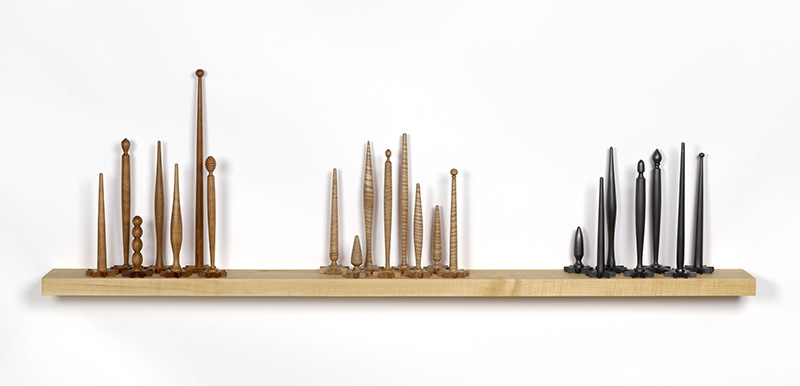
Gina Siepel. The Versatile Queer-All, A Study in Red, White, and Blue, 2018. Maple, cherry, graphite, oil finish. Image courtesy of the artist. Originally encountered in a 1913 how-to book entitled The Boy Mechanic, 1000 Things for Boys to Do, “The Versatile Querl” was a multi-purpose German kitchen utensil. Intended for mixing, mashing, juicing, and a variety of other uses, the Querl was said to be “better than anything on the market.” Here recast as a “Queer-All,” the Querl’s versatility is embraced for its metaphoric shape-shifting potentials. Inspired by diverse American design vocabularies, and fabricated using native hardwoods, the Queer-All draws on the aesthetics of sex toys, Shaker furniture, and historic New England woodworking.
For more information on the ongoing series of Queer Woodworking Roundtable discussions, please visit Center for Art in Wood to view their upcoming programming.
For a more in-depth examination on the issues of gender and sexuality within the history of woodworking, please see the recently released book by curator and woodworker Deidre Visser entitled Joinery, Joists and Gender: A History of Woodworking for the 21st Century.
John-Duane Kingsley is a contributing writer for The Decorative Arts Trust Bulletin. You can read more of his work at www.dandycraft.org.
[1] Lesbian, Gay, Bisexual, Transgender, Queer, Intersex, Asexual
[2] A person whose gender identity corresponds with the sex the person had or was identified as having at birth
About The Decorative Arts Trust Bulletin
Formerly known as the "blog,” the Bulletin features new research and scholarship, travelogues, book reviews, and museum and gallery exhibitions. The Bulletin complements The Magazine of the Decorative Arts Trust, our biannual members publication.







